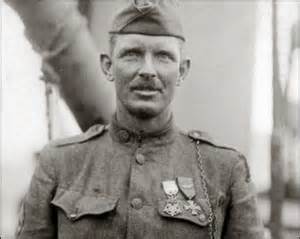The Heroism of Sergeant Alvin York
|

|
|
On This Site
|
|
• World War I
|
|
Share This Page
|
|
|
|
|
|
|
Follow This Site

|
 |
|
|
|
|

|
Alvin York was one of the most well-known American veterans of World War I. On a single day, he led a charge that resulted in the deaths of 28
German soldiers, the capture of 132 more, and the capture of 32
German machine guns.
York was born in 1887 in a log cabin in rural Tennessee, near the town of Pall Mall. The third of 11 children, Alvin helped his mother rear his younger siblings after his father died.
York was a religious man and regularly attended a Protestant church that opposed all forms of violence. When York signed up for the draft on June 5, 1917, he stated his conscientious objection to war. The army did not grant his objection, and York was drafted and sent to training camp in Georgia. He and thousands of other American troops were sent to
France to fight against Germany. Along the way, York kept a diary.
 Both sides were heavily entrenched, and many of the most famous battles were heavy exchanges of gunfire aimed at soldiers jumping out of trenches to run across "no man's land." On October 8, 1918, York's battalion took part in an attack on German positions north of Chatel-Chehery, France. German machine gunners were ensconced on high ground, and York and a few others were ordered to go behind enemy lines to take out the German guns. York was spectacularly successful, taking out several gunners and even capturing the head of the German battalion, who offered to surrender his entire unit.
Both sides were heavily entrenched, and many of the most famous battles were heavy exchanges of gunfire aimed at soldiers jumping out of trenches to run across "no man's land." On October 8, 1918, York's battalion took part in an attack on German positions north of Chatel-Chehery, France. German machine gunners were ensconced on high ground, and York and a few others were ordered to go behind enemy lines to take out the German guns. York was spectacularly successful, taking out several gunners and even capturing the head of the German battalion, who offered to surrender his entire unit.
In the end, the remaining 132 German soldiers were escorted under armed guard back to the American camp. The sum total of American soldiers doing the escorting was eight: York and seven of his fellow Americans. York was the highest-ranking one of the bunch, and so he was in charge. Recently promoted to corporal, York was named sergeant and awarded the Distinguished Service Cross and the Medal of Honor.
He also received awards from the French and Italian armed forces. Because his last rank was sergeant, he is often referred to as Sergeant
York.
York became famous back home when his story ran in a 1919 issue of the Saturday Evening Post. Some well-connected friends arranged a
five-day furlough for York, and he toured New York City and Washington, D.C., receiving a standing ovation on the floor of the House of Representatives.
York got his discharge from the U.S. armed forces and soon after married Grace Williams. A 1922 biography found favor with many American readers, and York soon found a publisher for his war diary.
He refused many offers that would have extended his fame, including appearance fees and movie rights to his life story. He did lend his name to a few charitable organizations. When money was tight, however, he approved a project for a movie about his wartime experiences. The result was the film Sergeant York, for which star Gary Cooper won the Academy Award for Best Actor.
York suffered from health problems throughout his life, and these accelerated after his return from the war. He did not fight in World War II. After a series of strokes and a bout with pneumonia, York died, in 1964. He and his wife, Grace, had eight children.